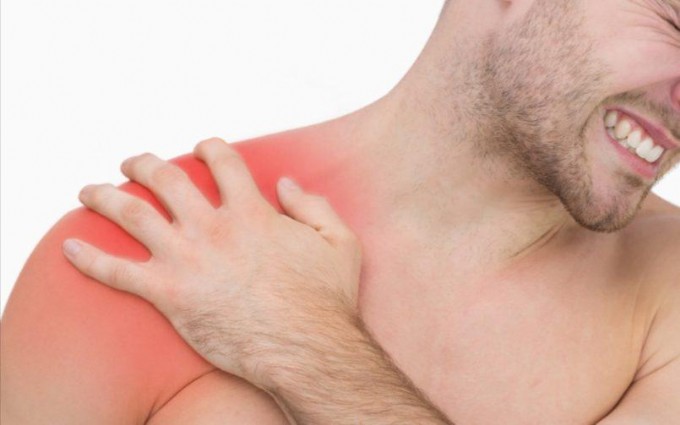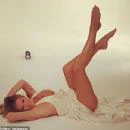Celebrities
What causes shoulder pain when walking uphill? Ask the GP DR MARTIN SCURR
I take a brisk 30-minute walk three times a week and am relatively fit. But when I come to an incline, I feel a dull ache in my right shoulder and the top of my right arm. My GP dismissed the possibility of it being angina, and suggested it may be a muscular issue, and to go back to them if it got worse (I am 72).

John Coleridge, Cheshire.
The symptom you describe is, in my view, highly suggestive of angina.
The textbook description of angina is that it causes chest pain that may radiate into the left arm.
But my experience built up over many decades is that it rarely presents this way. In fact, I've rarely seen angina patients with pain in the left shoulder or arm: typically, it leads to central chest pain, though the severity varies.
Angina is caused by a partial narrowing of the arteries. The pain occurs when the heart is working harder (for example, during exercise) and not enough blood is getting through.
You may find that your symptoms worsen if you take your walk after a meal and it may be more likely to happen in colder weather (in both instances the heart has to work harder). In some patients the angina pain is felt in the neck and jaw, while in others it's the upper abdomen. But the sensation can spread to both arms — or the right arm only.
s well as the pain, you might be slightly breathless. But the chief pattern to watch for is that this pain starts on exertion and stops when you rest.
I think you should see a cardiologist for further investigations.
This might lead to an angiogram, where dye is sent through the blood vessels and a form of x-ray is used to check how it flows through the coronary arteries.
If any blockage is found, you will be treated with medication, such as a nitrate spray for when angina occurs (it works by widening the blood vessels and increasing blood flow), pending a decision about further treatment.
You will almost certainly need medication to reduce raised cholesterol levels or high blood pressure, to reduce any further burden on the heart. You might also be advised to undergo a procedure to address any restriction in the blood flow in the two arteries — this involves having stents (tiny tubes) inserted into any narrowed segments to keep them open.
Latest News
I take a brisk 30-minute walk three times a week and am relatively fit. But when I come to an incline, I feel a dull ache in my right shoulder and the top of my right arm. My GP dismissed the possibility of it being angina, and suggested it may be a muscular issue, and to go back to them if it got worse (I am 72).

John Coleridge, Cheshire.
The symptom you describe is, in my view, highly suggestive of angina.
The textbook description of angina is that it causes chest pain that may radiate into the left arm.
But my experience built up over many decades is that it rarely presents this way. In fact, I've rarely seen angina patients with pain in the left shoulder or arm: typically, it leads to central chest pain, though the severity varies.
Angina is caused by a partial narrowing of the arteries. The pain occurs when the heart is working harder (for example, during exercise) and not enough blood is getting through.
You may find that your symptoms worsen if you take your walk after a meal and it may be more likely to happen in colder weather (in both instances the heart has to work harder). In some patients the angina pain is felt in the neck and jaw, while in others it's the upper abdomen. But the sensation can spread to both arms — or the right arm only.
s well as the pain, you might be slightly breathless. But the chief pattern to watch for is that this pain starts on exertion and stops when you rest.
I think you should see a cardiologist for further investigations.
This might lead to an angiogram, where dye is sent through the blood vessels and a form of x-ray is used to check how it flows through the coronary arteries.
If any blockage is found, you will be treated with medication, such as a nitrate spray for when angina occurs (it works by widening the blood vessels and increasing blood flow), pending a decision about further treatment.
You will almost certainly need medication to reduce raised cholesterol levels or high blood pressure, to reduce any further burden on the heart. You might also be advised to undergo a procedure to address any restriction in the blood flow in the two arteries — this involves having stents (tiny tubes) inserted into any narrowed segments to keep them open.

Jennifer Lopez looks ageless in a towel in no-makeup video

Amanda Holden spanks her derriere and thanks Spanx

Amanda Holden shows off more than bargained as she dances around in her outfit of the day

Meet Harley Cameron, the stunning model who went from a BKFC ring girl to become a pro wrestler and found love

GreenGirlBella, Rocks Emirates Stadium in Painted Home Kit

Amanda Holden calls herself a 'good girl' in white dress with 'cheeky' split

Mum slammed by parents after flashing thong in school run outfit

Lottie Moss makes jaws dropp as she shows off her flawless body

Amanda Holden wears nothing beneath plunging white dress












Comments
Written news comments are in no way https://www.showbizglow.com it does not reflect the opinions and thoughts of. Comments are binding on the person who wrote them.